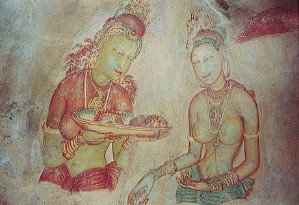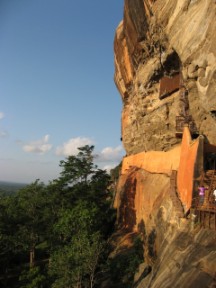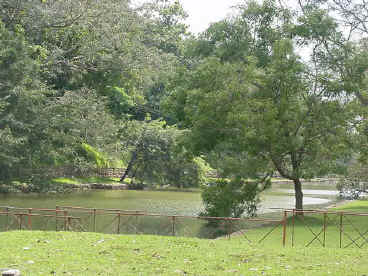
Sri Lanka's ancient architectural tradition is well portrayed at Sigiriya, the best preserved city centre in Asia from the first millennium, with its combination of buildings and gardens with their trees, pathways, water gardens, the fusion of symmetrical and asymmetrical elements, use of varying levels and of axial and radial planning. Sophisticated city planning was at the heart of Sigiriya, this royal citadel of ancient fame from the days of Sri Lanka's memorable past.
Wall Paintings on Sigiriya Rock Palace
The water gardens are built symmetrically on an east-west axis. They are connected with the outer moat on the west and the large artificial lake to the south of the Sigiriya rock. All the pools are also interlinked using an underground conduit network fed by the lake, and connected to the moats. A miniature water garden is located to the west of the first water garden, consisting several small pools and water courses. This recently discovered smaller garden appears to have been built after the Kasyapan period, possibly between the tenth and thirteenth centuries.

The garden city and the palace was built by king Kasyapa 477 - 495 AD.
Then after king Kasyapa's death it was a Buddhist monastery complex up to about the 14th century.

Sigiriya Rock Paintings
The ladies depicted in the paintings have been variously identified as Apsaras (heavenly maidens), as ladies of Kasyapa’s court and as Lightening Princess and Cloud Damsels.


The Sigiri Frescoes
John Still in 1907 had observed that; "The whole face of the hill appears to have been a gigantic picture gallery... the largest picture in the world perhaps”. The paintings would have covered most of the western face of the rock, covering an area 140 meters long and 40 meters high. There are references in the Graffiti to 500 ladies in these paintings. They would have been a breath-taking sight, when seen from the water garden below.
Though traces of plaster and pigments occur all over this area, there are only two pockets of paintings surviving in the depressions of the rock face, about 100 meters above the ground level. These paintings represent the earliest surviving examples of a Sri Lanka school of classical realism, already fully evolved by the 5th century, when these paintings had been made. Earlier the Sigiriya style had been considered as belonging to the Central Indian school of Ajanta, but later considered as specifically different from the Ajanta paintings. The ladies depicted in the paintings have been variously identified as Apsaras (heavenly maidens), as ladies of Kasyapa’s court and as Lightening Princess and Cloud Damsels. There are also remains of paintings in some of the caves at the foot of the rock. Of special significance is the painting on the roof of the Cobra Hood Cave. The cave with its unique shape dates from the pre-Christian era. The painting combines geometrical shapes and motifs with a free and complex rendering of characteristic volute or whorl motifs. It is nothing less than a masterpiece of expressionist painting


Rock Palace - Sigiriya SriLanka - Photographer Saranath
The pleasure garden of the western side of the rock is studded with ponds, islets, promenades and pavilions. Some underground and surface drainage systems have been discovered during excavations. The wall abutting the moat encircling the fortress is one of the most arresting features


Terrace Garden of Sigiriya Audience Hall Rock

Mirror Wall - "Ketapath Pawura"
On the western and northern sides of the steep rock face runs a gallery or pathway which provides access to the seemingly inaccessible summit. Shielding this pathway is a 9 1/2 ft. plaster wall, so highly polished, that even today, after fifteen centuries of exposure to sun, wind and rain, one can see one's reflection in it. Hence the name "Mirror Wall".


The water garden displays one of the world’s most sophisticated hydraulic technologies, dating from the Early Historic Period. This shows an interconnection of macro- and micro-hydraulics to provide for domestic horticultural and agricultural needs, surface drainage and erosion control, ornamental and recreational water courses and retaining structures and also cooling systems.
History of Sigiriya
Sigiriya dates back from over 7,000 years ago, through Pre-Historic to Proto-Historic to Early Historic times, then as a rock-shelter mountain monastery from about the 3rd century BC, with caves prepared and donated by devotees to the sangha. The garden city and the palace was built by king Kasyapa 477 - 495 AD. Then after king Kasyapa's death it was a Buddhist monastery complex up to about the 14th century. The Mahavamsa, the ancient historical record of Sri Lanka, describes King Kasyapa as a parricide, who murdered his father King Dhatusena by walling him up alive and then usurping the throne which rightfully belonged to his brother Moggallan. To escape from the armies of Moggallan, Kasyapa is said to have built his palace on the summit of Sigiriya, but Moggallan finally managed to get to Kasyapa and he committed suicide. However, there is also another version of the Kasyapa story, related by one of the most eminent historians of Sri Lanka, Prof. Senerat Paranavitana. He claims to have deciphered the story of Sigiriya, written by a monk named Ananda in the 15th cent. AD. This work had been inscribed on stone slabs, over which later inscriptions had been written. Till to date no other epigraphist has made a serious attempt to read the interlinear inscriptions.
Sigiriya is also the location for Arthur C Clerks ‘Fountains of Paradise’.

At one time a gigantic brick lion sat at the end of the rock, and the final ascent to the summit was between the lions paws and into it's mouth! Today the lion has disappeared, only the paws and the first steps are visible
https://www.facebook.com/cooraysaranath/videos/10158772845733618/
Sigiriya Video
https://youtu.be/BWlCb_NbyWY
Currency of SrilankaVideo
https://youtu.be/yPfMTLjTvyo